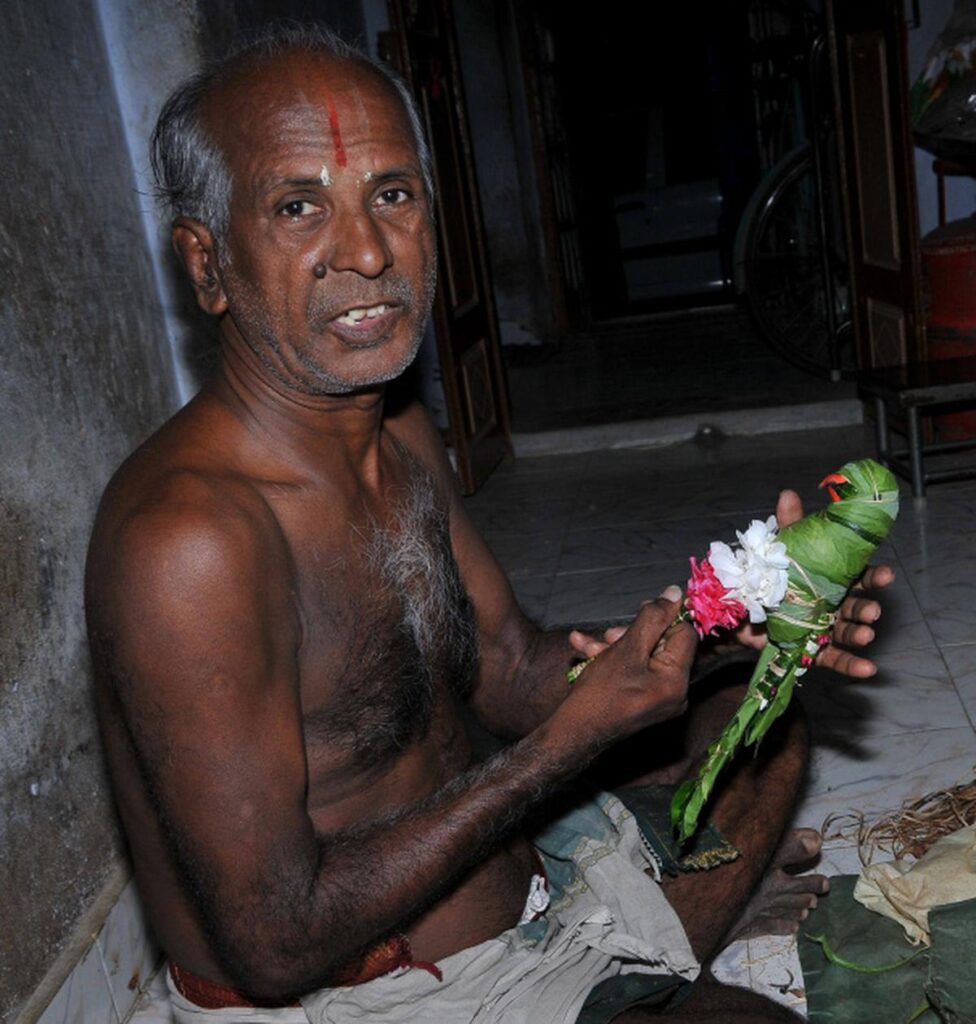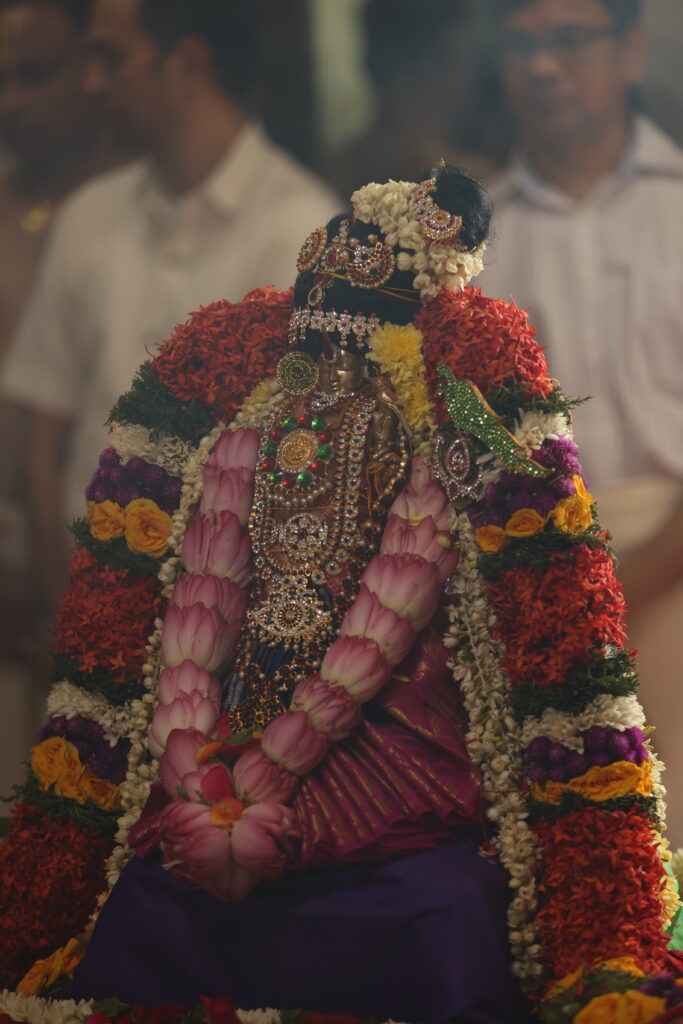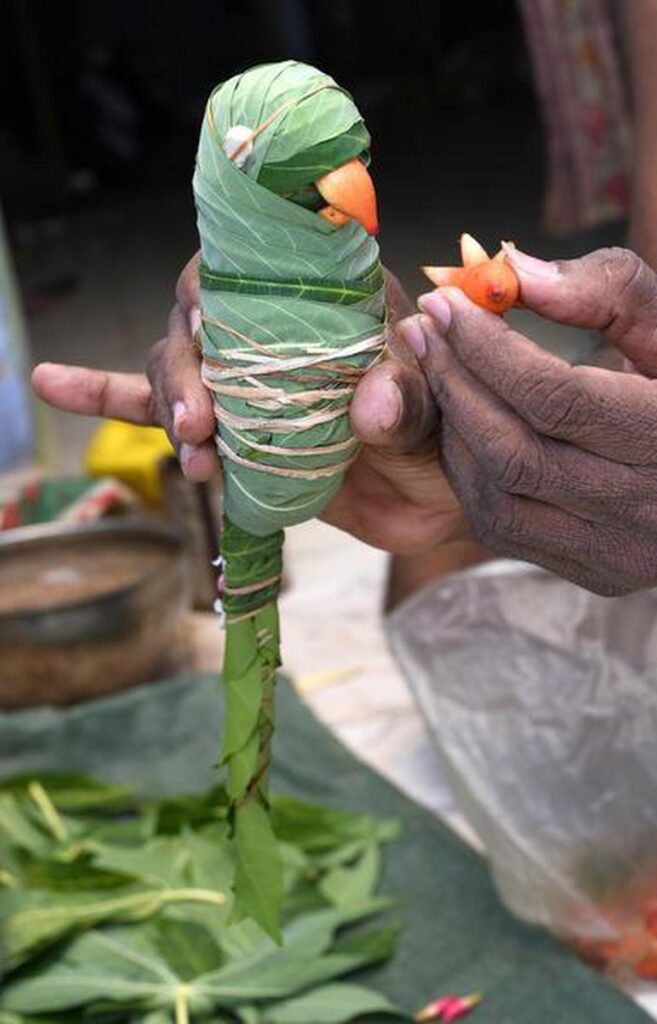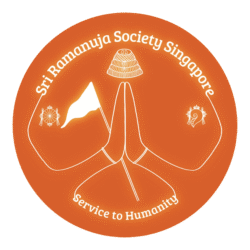By Smt. Sarvatha Varadharajan
In the sacred town of Srivilliputhur, where the divine verses of Tiruppavai still echo through the centuries and the towering gopuram rises like a painted hymn to the heavens, a quiet but profound tradition has been lovingly carried forward for over seven generations. This tradition centres around a simple yet deeply symbolic object: the green parrot.
These are not ordinary parrots, but puppet parrots made for Andal, the only female Alvar saint of the Tamil Vaishnava tradition. In her most cherished iconography, Andal is depicted with a delicate parrot perched on her shoulder, vibrant, alert, and exuding a divine presence. That parrot is not a mere ornament. It is a voice. It is poetry. It is love.
At the heart of this tradition stands S. Raman, a seventh-generation artisan from a Srivaishnava family, whose hands still shape these sacred parrots from leaves and flowers. His story is quietly powerful, an embodiment of devotion expressed through art.

PC: The Hindu
A Bird that Speaks of the Divine
To the casual observer, the green parrot on Andal’s shoulder might seem like a charming detail. But for devotees, it is a living symbol, believed to represent Sukha Brahma Rishi, the sage who took the form of a parrot to serve as Andal’s confidant, carrying her messages of longing and love to Lord Vatapadrasayi Perumal. In Nachiyar Tirumozhi, Andal refers to her parrot as “Paal amudhootti edutha en kolakkili”, a parrot that is lovingly fed with milk.

It is a messenger, a companion, and a silent witness to a sacred love story.
S. Raman, like his forefathers, does not merely make this bird. He offers it. Each feature, every curve of the beak, every shimmer in the eye, every texture of the feather, is shaped with devotion, meticulously crafted to reflect centuries of ritual and spiritual symbolism.
In Tamil culture, parrots are also seen as vessels of speech and song, echoing the poetic voice of Andal through her Tiruppavai and Nachiyar Tirumozhi. The parrot, then, is not only her companion but her song incarnate.
A Parrot made of Flowers
S. Raman’s parrots are made from natural materials, carefully selected for their symbolic and aesthetic qualities. The body is formed using pliable tapioca leaves, with palm fronds for wings and tail. The beak is crafted from pomegranate flowers, while the bamboo sticks serve as the legs. To decorate the parrot, he uses petals of crepe jasmine (nandiyavattei), hibiscus, and even the glittering kakkaipon stone for the eyes.
Each flower holds a vibrant and significant meaning to the divine messenger. For instance, pomegranate blossoms, with their deep red hue, represent fertility and sacred passion. Crepe jasmine, being pure and delicate as it is, whispers of spiritual purity. Hibiscus, a bold flower, evokes energy and offering, long associated with Lord Vishnu. The result is a living parrot, as transient and tender as a prayer, gently perched upon Andal’s shoulder, as if nature itself had come to speak her verses.

PC: The Hindu
For over two decades, S. Raman has devoted hours daily to crafting these parrots, an act of bhakti (devotion) more than mere craft. These offerings are not only sacred; they are living expressions of ancestral faith.
Beyond the Temple: Parrots in South Indian Weddings
The significance of these parrots extends beyond temple rituals. In many South Indian Brahmin weddings, brides are given green parrot puppets made of leaves and flowers to hold, echoing Andal’s image and invoking her blessings.
By carrying the parrot, the bride is symbolically linked to Andal, the divine bride of Rangamannar. The tradition becomes a subtle but powerful connection between sacred myth and modern marriage, between heritage and hope.
A Tradition on the Brink
Today, this sacred lineage continues through the loving hands of S. Raman. Like many traditional arts in the modern world, it faces challenges in being passed seamlessly to the next generation. While the future remains uncertain, S. Raman’s quiet dedication keeps the tradition alive, and there is always hope that his legacy will inspire others to carry it forward.
Honouring S. Raman and the Legacy
S. Raman’s work is a testament to the enduring power of devotion expressed through art. His parrots carry centuries of spiritual meaning, blending tradition, nature, and faith into delicate forms. It is also a gentle reminder that traditions like this often do not disappear with a roar, but fade gently, like incense in a shrine, or a final offering made at dusk. Yet, by telling these stories and honouring the hands that shaped them, we keep their spirit alive, like a parrot softly whispering Andal’s words across time.

2 Responses
Marvellous narration. 🙏🏻👍🏽
Call it a symbol or vahanam, the narrative nicely conveys the need to know/understand the significance of minutes that adorn our Deities.
As to remain crisp, I share one more thing. We call the Deity as “Vadabadhra sayee” whereas it is “Vatapatrasayee” is to be noted and corrected.
Mention of email ID is no issue. Varadarajan’s periappa
Blessings